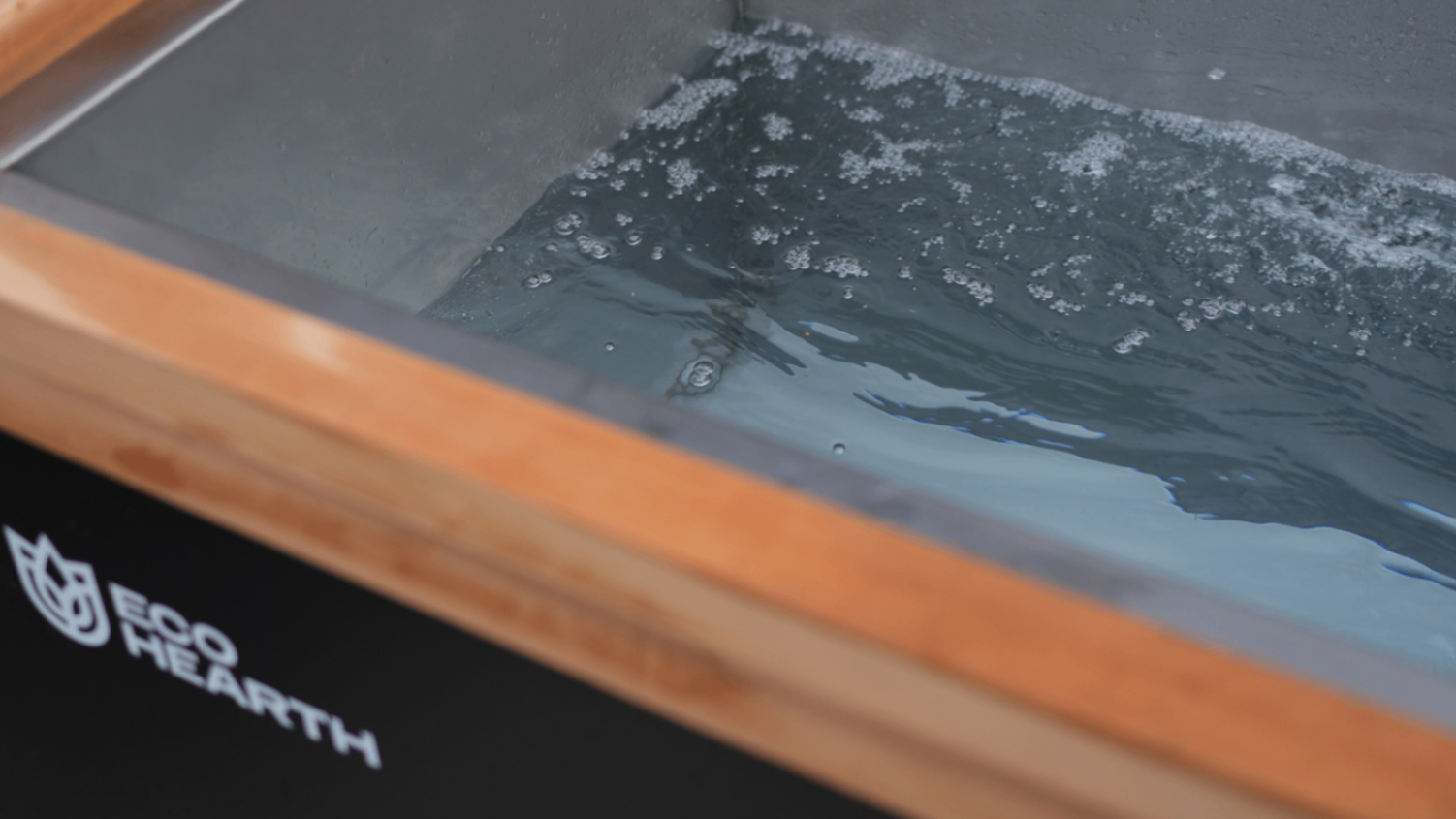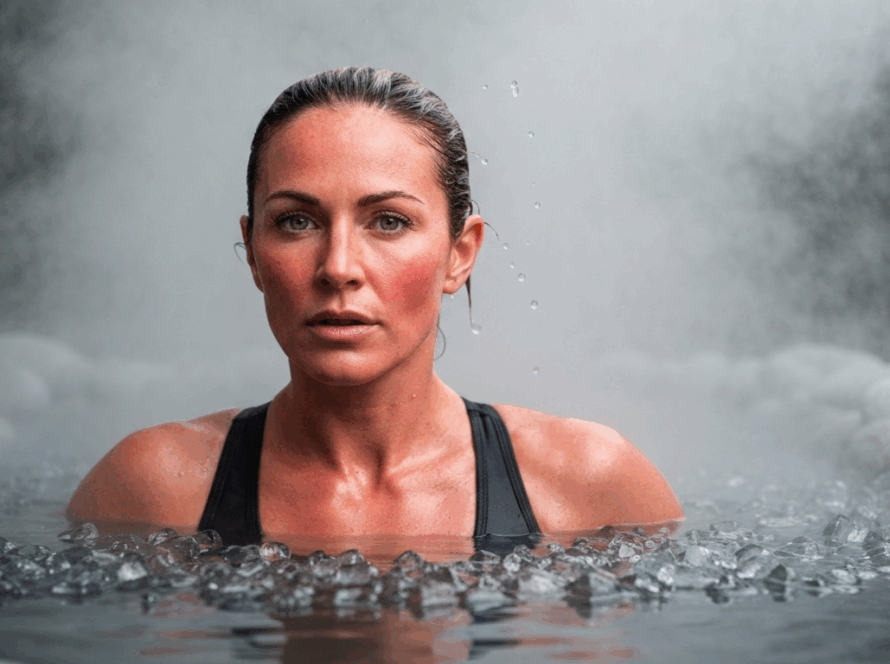Key Highlights
Imagine stepping into a world where the chill of ice-cold water invigorates your body and sharpens your mind. Cold ice baths are not just for athletes aiming to recover faster; they hold a treasure trove of health benefits waiting to be discovered by everyone. In this blog, we’ll delve deep into the science behind cold ice baths and explore their myriad advantages—from boosting circulation and reducing inflammation to enhancing mental resilience. We’ll also discuss potential risks, compare various cold therapy methods, and guide you through practical tips for incorporating ice baths into your routine. Whether you’re a seasoned bather or just curious about the buzz surrounding this icy practice, get ready to embrace the cold and transform your health from the outside in!
Introduction
The cold plunge, also called a cold therapy or ice bath, is getting popular in many homes today. It used to be something only top athletes did. Now, many people, including celebrities and folks you know, are trying it out. There is a lot of science behind the health benefits of this wellness trend. The ice bath has been used for a long time.
Do you want to know why people get into cold water for their health? This guide breaks down what happens in your body when you take a cold plunge. You will learn about health benefits, the way your body reacts, and tips to try it at home in a safe way.
Understanding Cold Ice Baths: The Basics
Cold water immersion is not new. People have used cold plunge methods for hundreds of years. The idea is clear. You put your body in cold water for a short time. This move can give many health benefits. In fact, the ancient Greeks did winter swimming and enjoyed the cold water. Today, this way of feeling better is now part of regular life.
Taking an ice bath is easy to do now. You can use a regular tub with ice or a special cold plunge setup that chills itself. The icy waters can help many people. Let’s talk about what taking a cold ice bath means and how cold water affects your body.
What Is an Ice Bath?
An ice bath is a therapeutic practice involving immersion in cold water, typically around 50°F (10°C) or lower. Often utilized by athletes for recovery, this method aims to reduce muscle soreness, inflammation, and enhance overall physical resilience.
How Does Cold Water Immersion Work?
When you go into cold water, your body starts to change right away. It does this to keep in heat and protect the main parts inside you. The first thing that happens is called vasoconstriction. This means your blood vessels in your arms and legs get smaller. This change pushes blood toward your core. That helps hold in your core body temperature.
Being in cold water is a small type of stress for the body. Your heart rate goes up, and your breathing gets faster. This happens because your body thinks it needs to fight or run. If you keep calm and control how you breathe, your nervous system begins to settle down. This is an important part of the mental work you do as you get used to cold water immersion.
When you get out of the plunge tub, your blood vessels open up again. Blood full of oxygen moves back to your muscles and skin. This can help remove things in your body that build up when you work out. The faster clean-up is thought to help you recover from exercise. If you are new to cold water or cold plunge, it is important to start slow. Use warmer water and do it for a short time first. Then slowly make it colder and stay in longer as your body gets used to it.
Brief History and Popularity in the U.S.
Using cold water for health goes way back. The ancient Greeks used cold and hot water, a method called thermalism, to help with tiredness and feel better. This old way of doing things started many of the modern hydrotherapy methods that we see now. In some places, like Nordic countries, winter swimming has kept cold water traditions going for many years.
In the United States, cold water immersion became popular because of sports medicine. Athletes use ice baths after working out to help their muscles recover faster and lower soreness. This helped show people cold water can be useful and brought it more attention.
Lately, cold plunges have become popular outside of sports. More people in the health and wellness world talk about cold water. Social media and celebrities helped show how cold water can help with mental health, lowering stress, and even bringing down high blood pressure if a doctor says it is okay. Now, lots of people want cold plunge setups at home. They use simple tubs or more advanced machines that can cool themselves.
The use of cold water, cold plunge, cold water immersion, and winter swimming is now helping people learn new ways to care for mental health, muscle soreness, and blood pressure every day, just like the ancient Greeks did a long time ago.
The Science Behind Ice Baths
Cold water immersion triggers a range of physiological responses in the body, enhancing muscle recovery and reducing soreness. Exposure to lower temperatures constricts blood vessels, minimizing inflammation and allowing for improved blood flow upon rewarming. This process is vital for athletes seeking to optimize their performance and speed recovery times. Furthermore, the activation of the nervous system during cold plunging promotes heightened mental clarity and support for the immune system. Understanding these biological processes underscores the benefits of a cold plunge and the potential it holds for improving overall wellness and physical activity outcomes.
How Cold Temperatures Affect the Body
Exposure to cold temperatures initiates a series of physiological responses that can significantly influence overall health. When the body experiences a drop in temperature, blood vessels constrict, redirecting blood flow to vital organs, which helps maintain core body temperature. This process not only aids in muscle recovery by reducing inflammation but also enhances the immune response by stimulating white blood cell production. Moreover, regular cold water immersion can improve mental clarity and cognitive function, as the shock of cold exposure prompts the release of endorphins, creating a sense of well-being and increasing alertness.
Key Biological Responses to Cold Exposure
Exposure to cold temperatures triggers several biological responses that can significantly enhance overall health. The body activates thermogenesis, generating heat to maintain core body temperature, which can lead to improved metabolic activity. Blood vessels constrict, promoting better blood flow upon re-warming. This process can reduce inflammation and support muscle recovery, essential for athletes and active individuals. Furthermore, cold water immersion enhances the immune response, bolstering defenses against illness while providing a boost to cognitive function and mental clarity. These biological adaptations contribute to the multitude of benefits associated with cold exposure therapy.
What the Research Says (With Authoritative Sources)
Emerging studies underscore the substantial health benefits of cold water immersion. Research published by the American Heart Association highlights improved blood flow and reduced inflammation post-exercise, vital for effective muscle recovery. Other investigations into cold therapy demonstrate its positive impact on cognitive function and mental clarity, enhancing overall well-being. The integration of cold exposure into routine practice can potentially lower heart rate and blood pressure, contributing to better cardiovascular health. As findings accumulate, the significance of cold plunging as a holistic approach to wellness becomes increasingly evident.
Top Health Benefits of Cold Ice Baths
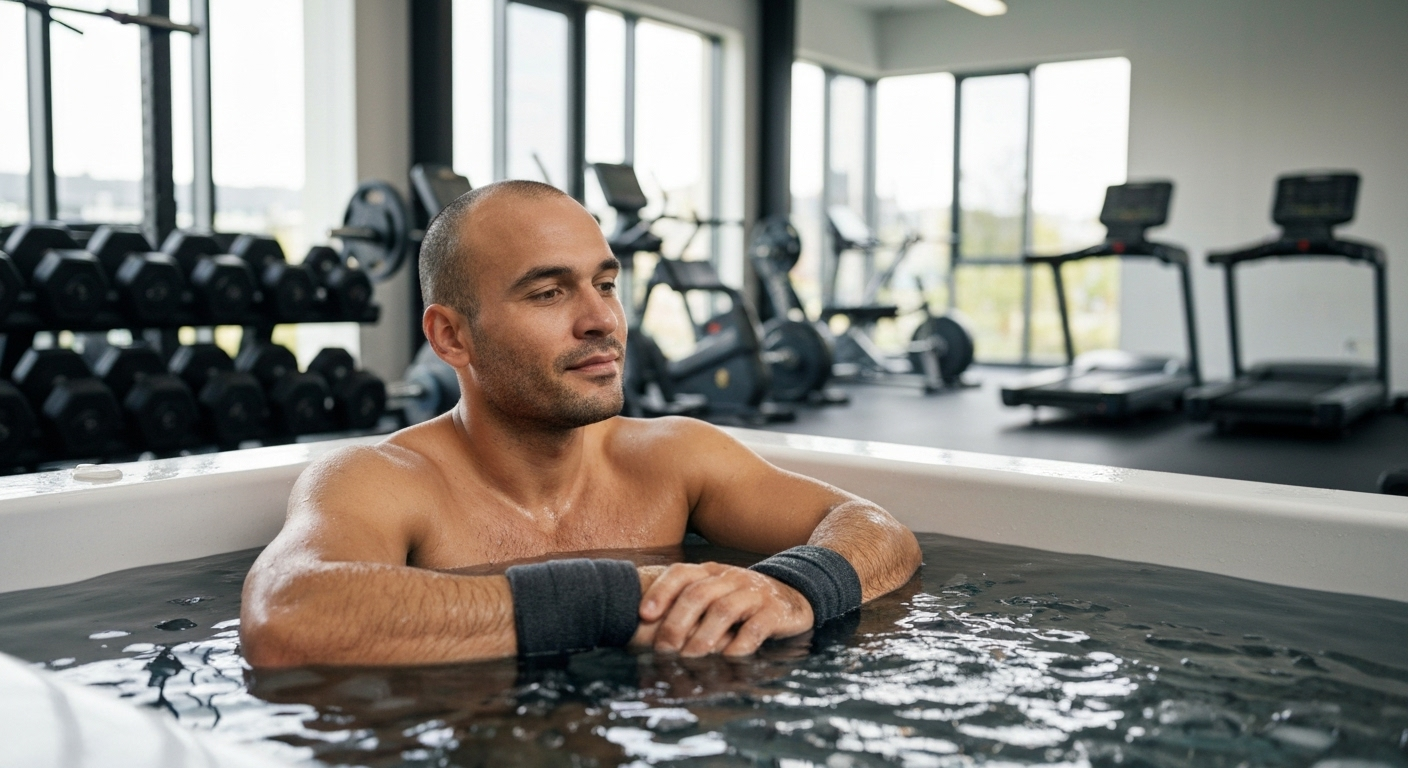 Many people want to try a cold plunge even though it can be really cold. They do this because there are many strong health benefits that you can get. Cold water can help with things like muscle recovery and making your mind feel clear. It is not just something to wake you up. A cold plunge can help your body heal and work better.
Many people want to try a cold plunge even though it can be really cold. They do this because there are many strong health benefits that you can get. Cold water can help with things like muscle recovery and making your mind feel clear. It is not just something to wake you up. A cold plunge can help your body heal and work better.
When you get into cold water, your body has some special reactions. Cold water immersion can help lower inflammation. The cold makes blood flow better. It can also help calm your nervous system. You may find that you get these health benefits when you try cold water for yourself.
Enhanced Muscle Recovery After Exercise
After you do a lot of physical activity, you may notice that your muscles get sore and feel swollen. Taking a cold ice bath can really help with muscle recovery. Dr. Dominic King, who works in sports medicine, says the cold water makes your blood vessels tighten. This slows blood flow and eases swelling and soreness. It may help you get back to your training sooner.
Cold therapy like an ice bath works especially well for treating muscle soreness that shows up a day or two after tough exercise, known as delayed onset muscle soreness (DOMS). The cold water can keep swelling low, which lowers how bad the pain gets.
Key recovery benefits include:
- Reduced Swelling: Tight blood vessels can keep swelling down in muscle fibers.
- Flushing Waste Products: Blood flow changes can help move out waste from your muscles, like lactic acid.
- Pain Relief: The cold helps numb sore muscles so you feel less pain.
Can a cold ice bath help your muscles recover after you work out? Yes, research and what athletes say show that it is a good way to help stop soreness and speed up recovery. This lets you train more often and feel better quicker.
Reduced Inflammation and Pain Relief
One of the main benefits of cold therapy is that it helps cut down on inflammation. When you try cold water or do a cold plunge, your body temperature drops. This makes your blood vessels get smaller. The Cleveland Clinic says this process can help bring down swelling from inflammation and give real relief.
The way cold water impacts inflammation also helps with pain. The cold slows things down in your nerves, sending pain messages to your brain much slower. This gives a natural numbing feeling that eases sore spots and gives some temporary comfort.
That is why cold water immersion is used a lot in sports medicine when there is an injury. People living with ongoing swollen joints or sore muscles often use cold plunges or cold water routines too. While cold therapy can’t cure these problems, a lot of people say taking regular cold plunges helps keep their symptoms in check and makes their lives better.
Improved Circulation and Cardiovascular Health
Taking a regular cold plunge can feel like a workout for your body’s circulatory system. When you move from hot to cold, your blood vessels quickly get smaller and then bigger. Over time, this helps the blood vessels in your body get more flexible and work better. Because of this, you get better blood flow all over the body.
Better circulation means your cells get more oxygen and other important things they need. Waste leaves the body faster, too. This can help with good heart health in the long run.
But, you need to be careful. The first time your body hits the cold, your blood pressure goes up. Your heart has to work harder. For many people, this can be good stress on the body. Still, the American Heart Association says it can be risky if you already have heart conditions or high blood pressure. So, if you are thinking about using a plunge tub to boost blood flow or for your heart, it’s best to talk to your doctor first.
Boosted Mental Clarity and Stress Reduction
The benefits of a cold plunge are not just about the way it helps your body. Many people say they feel more clear-headed and less stressed after trying it. The reason for this is the way your body reacts to the cold water. The cold makes your body release norepinephrine, and this chemical helps you feel more awake, focused, and in a better mood.
A cold plunge or ice bath also helps your nervous system deal with stress. When you go into very cold water, the shock can be tough. If you calm yourself and slow your breath, you help your body learn to relax. This helps your parasympathetic nervous system, the “rest and digest” part, take over from the “fight or flight” feeling. Over time, you get better at staying calm, even in stressful moments throughout your day.
Some people now start their day with a cold plunge instead of coffee. They say they feel more awake and focused, and that the feeling lasts longer. The main health benefits of taking an ice bath or cold plunge include strong changes in your mental health, your sense of clarity, and the way your nervous system works.
Potential Risks and Safety Considerations
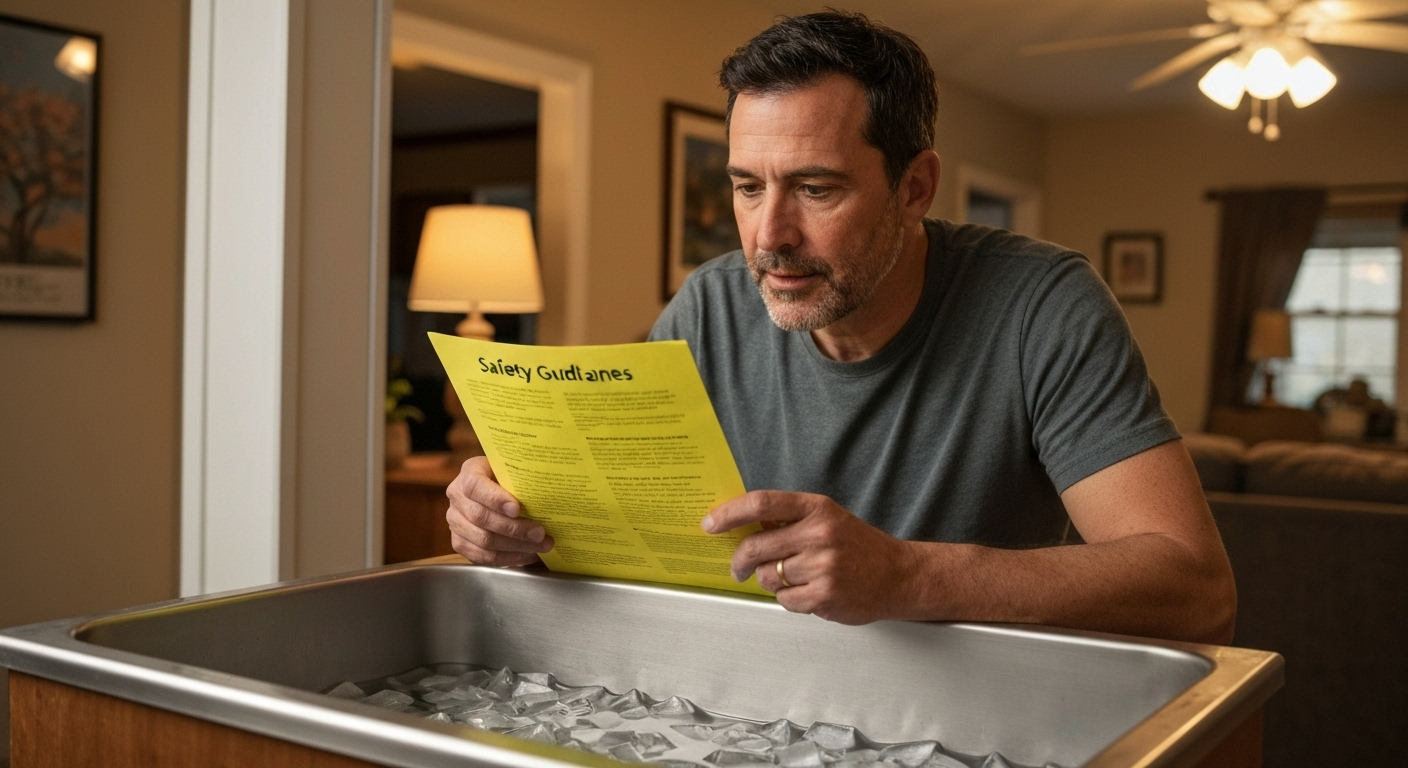 While cold water immersion can give many benefits, it is a strong practice that comes with some risks. The shock from the cold puts a lot of stress on the body, mainly on the heart and blood vessels. It is important to be careful and think about your own health before you start.
While cold water immersion can give many benefits, it is a strong practice that comes with some risks. The shock from the cold puts a lot of stress on the body, mainly on the heart and blood vessels. It is important to be careful and think about your own health before you start.
You need to know who should stay away from cold water plunges and the safe way to do them. Having some medical conditions or feeling some common side effects can affect how your body handles the cold. If you learn more about these things, you can enjoy cold water therapy and not put your safety at risk. Here is what you should know.
Who Should Avoid Cold Ice Baths?
Cold ice baths are not safe for everyone. The strong effects they have on your body can be risky for some people, especially those with medical conditions. One big concern is how the cold can make your heart rate and blood pressure go up quickly.
Before you start a cold plunge, talk to your doctor. This is important because they can help you know if this type of cold therapy is safe for you, based on your health.
Experts in healthcare say to stay away from cold plunges if you have:
- Heart Conditions: Like heart disease or if you have had a stroke before.
- High Blood Pressure: Because cold can make blood pressure jump quickly and this is dangerous.
- Diabetes: Cold affects blood flow and nerves in your body.
- Pregnancy: It’s best not to do cold plunges if you are pregnant.
Your safety comes first. If you know that you have issues with your heart, your blood pressure, or your circulation, you should talk to a doctor before getting into a cold plunge. It’s important for your health and not something you should skip.
Common Side Effects and How to Minimize Them
Even for people who are in good health, cold exposure can still bring about some side effects that are not comfortable. The most common feeling is a strong or sometimes painful sense of cold, especially when you go through this in the first few times. You may also find yourself shivering, having temporary numbness in your hands or feet, or noticing your skin turning red.
To help keep these effects down, it is good to start slow. Do not put yourself straight into water that is nearly freezing for your first try. It is much better to use warmer water, about 60°F, and only stay in for 1 or 2 minutes. Then, as your body gets used to the cold exposure, you can lower the temperature and spend a bit more time in the water.
One other big danger is that your core body temperature or body temperature could drop too much. This can lead to hypothermia. That is why you should never stay in the water too long—most experts say to keep your time under five minutes when the water is really cold. Always pay attention to your body, and get out if you start feeling very dizzy, mixed up in your mind, or if you cannot stop shivering.
Safe Practice Guidelines from Experts
Following advice from experts is the best way for you to make your cold therapy safe and useful. Professionals say, like Dr. Dominic King, that you should start low and go slow. This is about the temperature and how much time you stay in. If you are new, start with water between 50 and 59°F, and be in it for only a few minutes.
Another important safety step is to never do a cold plunge alone. This is even more true if you are new to the activity or you go in open water. Having someone with you is a simple and important way to keep safe. You should also not jump right into a hot shower after your cold plunge. Let your body get warmer on its own. This helps you get the best metabolic benefits. You can have a warm drink or move around a bit to help with this.
Are there risks when it comes to cold ice baths? Yes, there are, especially for people who have heart conditions. The stress on your heart, risk of getting too cold, and chance of nerve problems are real if you stay too long. If you follow cold therapy safety rules and talk to your doctor, you can lower these risks and make cold plunge a good experience for you.
Comparing The Cold plunge, Ice bath, and Contrast Therapy
Different methodologies exist for enhancing recovery and overall health through cold exposure. Ice baths offer a deep plunge into icy waters, facilitating rapid muscle recovery and reducing soreness. In contrast, cold plunges maintain a stable temperature for consistent therapy, focusing on the benefits of cold water immersion over extended periods.
Contrast therapy combines hot and cold treatments, stimulating blood flow and enhancing circulation. Each approach has unique merits, contributing differently to mental clarity and physical wellness. Whether seeking muscle growth or improved heart health, understanding your needs helps in selecting the best method for optimal recovery.
How Contrast Therapy Works (Sauna + Ice Bath)
Contrast therapy is when you move between hot and cold places. Most people do this by going from a hot sauna to a cold bath. This helps your blood flow in your body and gives you special health benefits.
When you sit in the sauna, the heat makes your blood vessels get wider. This means more blood goes to your skin. After the sauna, you go into a cold bath. The cold makes your blood vessels get tight again and sends the blood back to your core.
Doing this cycle of warming up and cooling down makes your blood flow even better than using just heat or just cold by itself. It may also help lower inflammation, help your body recover, and leave you with a strong sense of energy. You get the best results when you use an Eco Hearth outdoor sauna along with an ice bath or cold bath at home. This gives you a great wellness routine using both hot and cold therapy for your blood vessels and blood flow.
Which Method Of Cold Water Plunge Is Best for You?
Choosing the best cold plunge for you comes down to what you want, how much you want to spend, and how often you will stick with it. If you just want to try a cold plunge and see how it goes, an ice bath in your bathtub is a good and low-cost way to start. You can set it up with what you have at home without spending a lot.
If your goal is muscle recovery or mental health, and you plan to use cold plunge often, a special plunge tub is your best pick. It gives you cold and clean water anytime you want, so it’s much easier to keep up with your routine. Getting an advanced one with a strong chiller lets you get the perfect cold temperature for what you need while staying ready to use.
For the best health benefits and a more complete wellness experience, try contrast therapy if you like saunas. This gives you big benefits for your blood flow and can help with overall health. Think about what motivates you the most—muscle recovery, stronger mental health, or just overall wellness. Pick the cold plunge method that fits your health goals.
The Beginner’s Guide to Ice Bathing
Embarking on the journey of ice bathing can seem daunting, but preparation is key. Start by gathering essential equipment, such as a cold plunge tub and a reliable thermometer to ensure the water temperature is optimal. Setting up your space—whether indoors or outdoors—should prioritize safety and comfort. Mental and physical preparation plays an equally significant role. Familiarize yourself with breathing techniques, and visualize the process to ease anxiety. Committing to this invigorating practice may yield numerous health benefits, including enhanced muscle recovery and improved mental clarity, making every moment in the ice bath worthwhile.
Essential Equipment and Resources Needed for The plunge Ice bath
Creating an effective cold ice bath experience requires specific equipment and resources to optimize both safety and benefits. A quality cold plunge tub is essential, preferably with features like an electric chiller and stainless steel construction for durability and temperature control. Additionally, ensure you have a thermometer to measure water temperature accurately, keeping it in the recommended range. Adequate towels and warm clothing are necessary for post-bath warming, promoting recovery and comfort. Lastly, consider incorporating filtration systems to maintain water purity, ensuring a safe and pleasant immersion experience.
Setting Up Your Space: Indoors vs. Outdoors
Creating the right environment for your cold ice bath experience is crucial for maximizing its benefits. Indoors, consider a dedicated space with easy access to warm water for post-bath recovery. Ensure the area is well-ventilated to maintain comfort. Outdoor setups can take advantage of natural elements but require a reliable source of cold water, such as a cold plunge tub equipped with an electric chiller. Whether indoors or outdoors, prioritize privacy and prepare the surroundings to foster a sense of calm, enhancing the mental clarity and relaxation that follow your session.
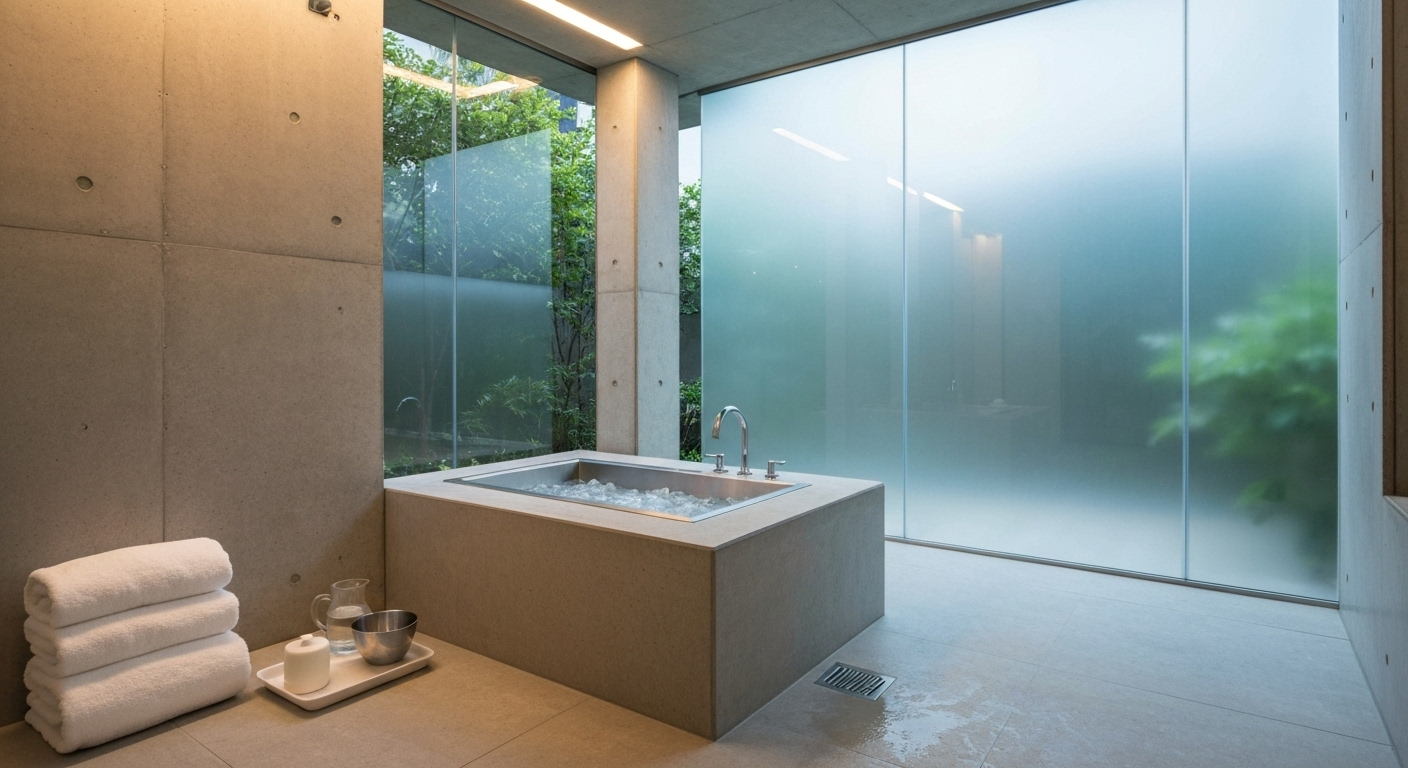
Preparing Yourself Mentally and Physically for Cold Water Bath
Embracing cold water immersion requires a mental and physical readiness that enhances the experience. Visualizing the invigorating benefits of the cold plunge can boost confidence and resilience. Brief breathing exercises or mindfulness techniques can help to calm the nervous system, lowering heart rate and alleviating anxiety. Physically, acclimatizing the body through gradual exposure to lower temperatures is crucial. Start with milder cold baths, gradually decreasing water temperature over time. This approach not only builds tolerance but also prepares the body to adapt to the shock, ensuring a smoother transition into deeper, colder experiences.
How to Take Your First Cold Ice Bath
You have set up your space and you feel ready for this. Now, it is time to get into the main thing. Taking your first cold ice bath is an important step. To get the most out of it and stay safe, you need to follow some clear steps. This guide shows you how to do the plunge in five easy steps.
From setting the water temperature to warming your body after you get out, every step here helps you have a good and safe time in the cold tub. Let’s go through your first cold exposure session together.
Step 1: Setting the Right Water Temperature
For people starting out with a cold water ice bath, try to keep the water at a temperature between 50°F and 59°F (10°C to 15°C). This range is good because it lets you get the most out of the ice bath without feeling too shocked by the cold. You do not need to go colder, especially for your first time.
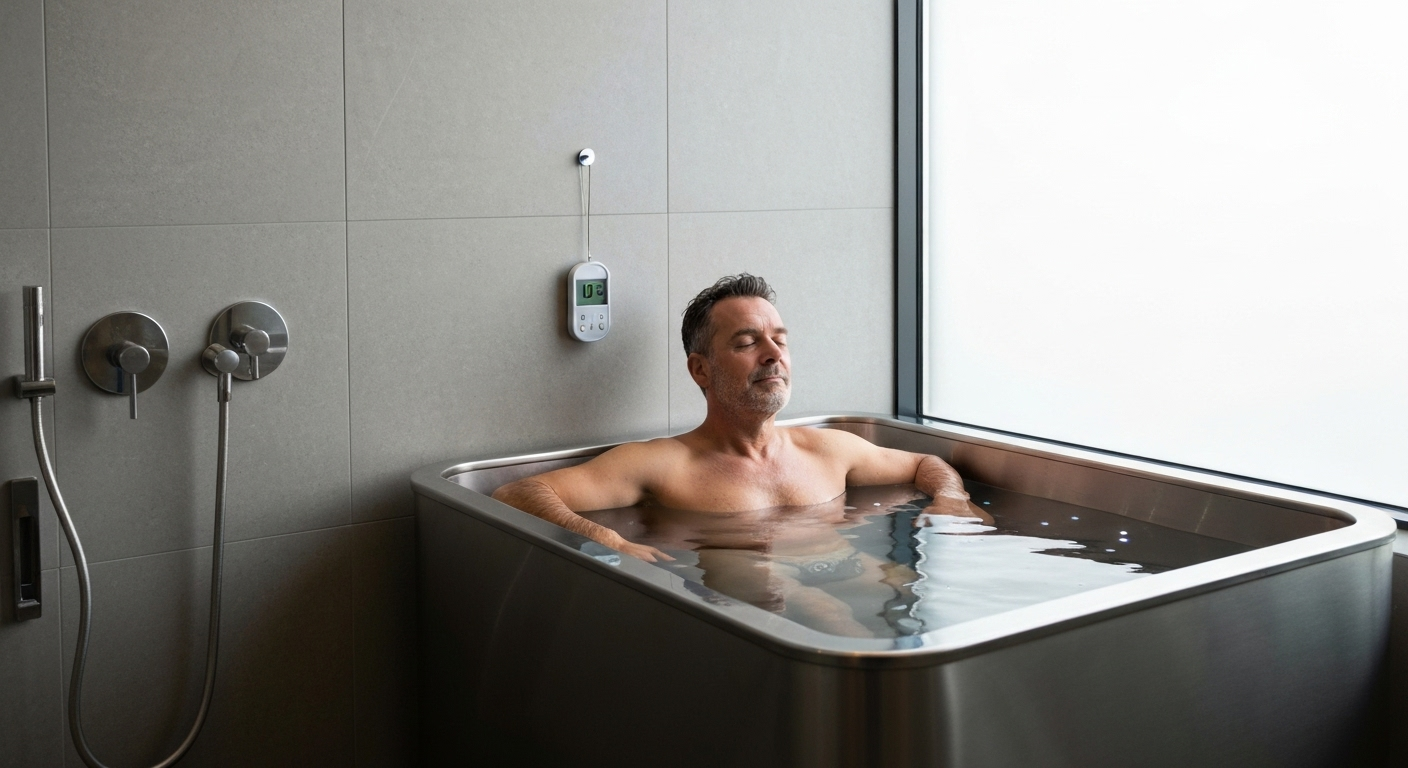
If you use a normal plunge tub at home, fill it halfway with cold water. Then, slowly add ice cubes, and check the temperature with a thermometer until it reaches your desired temperature. It is okay to begin when the water is a little warmer and add more ice if you want the water to get colder.
If you have a special plunge tub or chiller, the job is even easier. High-end tubs, like the Eco Hearth Ice Bath, let you set the desired temperature from an app. The chiller takes care of cooling the water until it is at the right temperature for you. The bath will be at the same coldness every time you get in.
Step 2: Safely Entering the Bath
How you get into the water is very important. Never jump or dive in, as this will make the shock harder on your body and your nervous system. Instead, try to get into the plunge tub slowly and with care. Sit on the edge first, then put your feet and legs in.
As you lower your body into the plunge tub, work on controlling your breath. Most people want to gasp and take short, quick breaths. Try not to do that. Take a slow, deep breath in, then breathe out slowly as you put your body in the water. This tells your nervous system that you are in charge.
Keep going until the water comes up to your neck. If the cold is too much, you can keep your hands out of the water. Remember, getting into the plunge tub is often the hardest part. If you move in with care and pay attention to your breath, you will feel better and it will be safer for you.
Step 3: How Long to Stay In for Maximum Benefit
If you are new to an ice bath, start with a short time. Try to be in the cold water for one to three minutes at first. It is enough to help your nervous system and get the recovery started. Do not stay too long in the water.
After some time, the body starts to get used to cold exposure. Susanna Søberg and other experts have found that doing a total of 11 minutes each week, in short bursts, works best for long-lasting benefits. This way you help your immune system and also boost your metabolism. There is no need to push yourself for long and hard sessions. Short and steady cold exposure is good.
Pay attention to your body. The most important thing is to test yourself but not to hurt yourself. The moment you feel dizzy or begin to shiver a lot, get out of the ice bath. It is not about the timer, but how you feel. Having a steady routine is better than spending more time in cold water.
Step 4: Breathing and Relaxation Techniques
Your breath is the best way to deal with cold water. Many people on social media breathe fast, but that is not the best way to calm your nervous system. It is better to take slow and steady breaths. This can help you go from feeling stress to feeling relaxed and in control.
When you are in the water, try to keep your breathing regular. One way to do this is box breathing or making sure your exhales are longer. This will let your body know you are safe and will help you relax. It also makes your mental clarity better.
You can try these relaxation ideas when you do your plunge:
- Slow Nasal Breathing: Breathe in slowly through your nose. Breathe out even slower through your mouth or nose.
- Body Scan: In your mind, check your whole body and try to relax every muscle that feels tight.
- Mantra or Focus Point: Say a calming word or phrase to yourself, or look at one spot to help your mind be quiet.
Using these techniques supports your nervous system and boosts mental clarity while you are in the cold.
Step 5: Warming Up After Your Ice Bath Cold Plunge
How you warm up after your cold plunge is just as important as the plunge. Do not jump right into a hot shower or sauna after. Your body works hard to raise its own body temperature, which can help boost your metabolism. Let this happen on its own to get the most out of your session.
After you get out of the water, dry off fast with a towel. Then put on warm, dry clothes right away. Make sure you use socks and a hat too. Your core body temperature may keep dropping for a few minutes after you leave the water. This “after-drop” means that getting yourself warm and insulated is very important.
Simple moves, like walking or easy stretching, can help bring up your body temperature and get blood flow back to your hands and feet. A warm drink, such as herbal tea, can help with warming you up from the inside. If you are doing hot and cold contrast therapy, always finish on the cold to get the best outcome.
Tips for Making Cold Ice Bathing Easier
The first times you try a cold plunge, it can be hard. Your body and mind need time to get used to something new and strong like this. The good news is, there are tips the people use that can help and make the cold plunge feel better as you go.
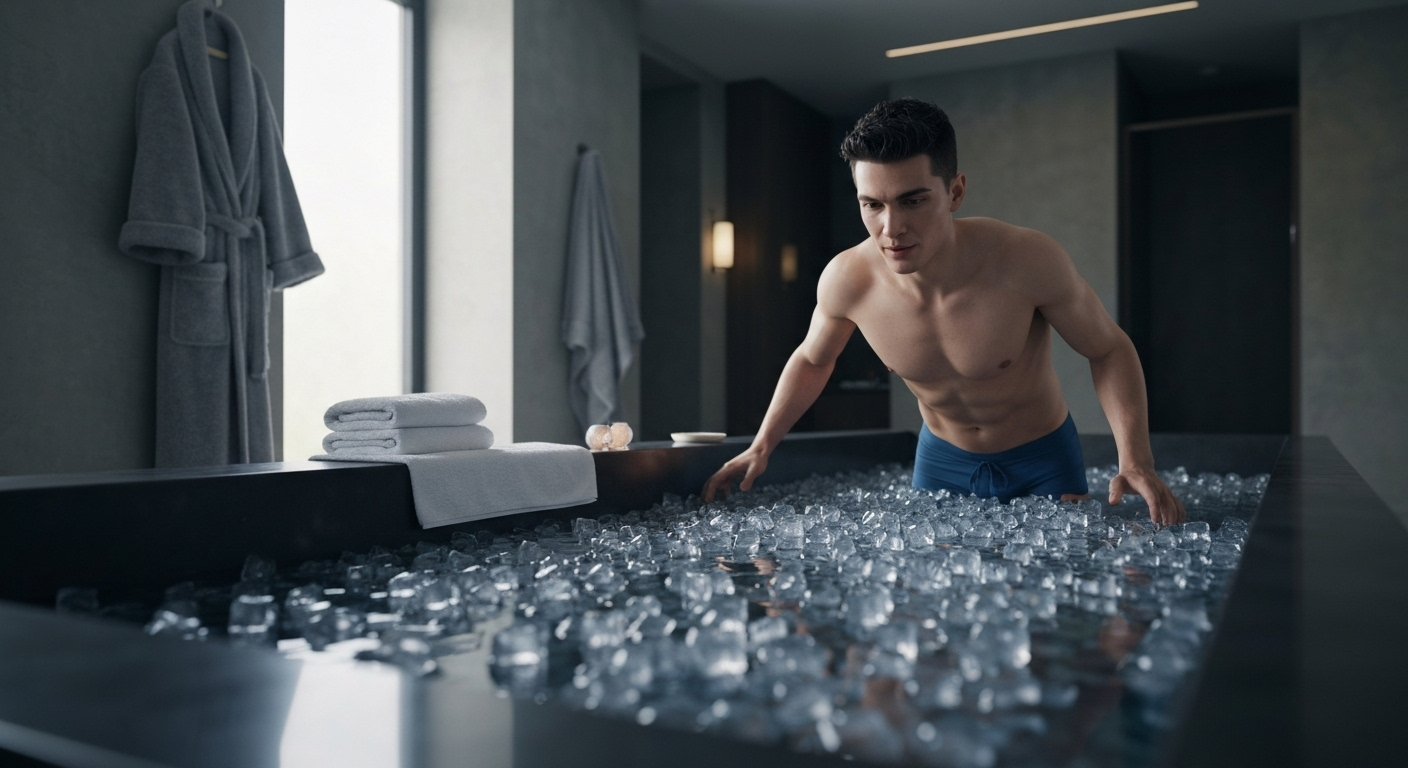
Some things that work be starting slow and letting your body get used to it. You can also distract your mind, so it does not focus just on the cold. These ways can help you face those first few tough moments. If you keep practicing, and if you get the right support, your cold plunge can change. It can go from being a tough thing to being a way to feel fresh and good.
Gradually Building Your Tolerance an Ice Bath Plunge
The main thing you need to remember for cold exposure is to grow your tolerance slowly. You should not try to sit in a 39°F bath for five minutes right from the start. The best way is to go step by step. This goes for both water temperature and how long you stay in.
Start with water that is between 50°F and 59°F. Stay in for just one to two minutes. When you feel more at ease after trying this a few times, you can lower the water temperature by a few degrees. You can also stay in for another minute. Doing this bit by bit gives your body time to get used to it. It is good for your blood flow and your nerves.
Going slow like this helps you avoid getting too stressed or having bad side effects. It helps you turn cold exposure into a regular part of your life. This lets you enjoy the benefits for the long run.
Using Music, Meditation, or Distraction Techniques
Keeping your mind busy is one good way to deal with the cold in a cold plunge. If you use tricks to shift your focus, it can help you not think so much about the cold feeling. This helps the time in the water to go by faster and makes it easier.
Many people listen to music, a podcast, or a guided meditation when they do a cold plunge. The sound helps your brain think about something else besides the cold. This is very useful for those who are new and still learning what a cold plunge feels like.
Here are a few tips you can try:
- Create a Plunge Playlist: Pick songs that are upbeat and will get you moving, or choose quiet tracks that help you calm down.
- Guided Breathwork: Pick an app or a recorded voice to help lead you during breathing practices while you are in the water.
- Mindfulness: Instead of trying to forget the cold, focus strongly on one thing, such as how the water feels on your skin or on the sound you make when you breathe.
This can help you have a better time and get more out of your cold plunge.
Supportive Gear: Gloves, Socks, and More
Some people find that using a few extra items can make the cold tub feel better, even though it is not needed for everyone. This can help a lot, mostly when you start with colder water. The hands and feet often get cold fast. Many people say these parts hurt more than any other when they use a cold tub.
If you wear neoprene gloves and socks, they keep your hands and feet from getting so cold. With these, you can stay in the cold tub for a longer time. It can help you focus on how the cold helps your bigger muscles and your core. Such small changes help you feel much more comfortable in the water.
It can also help to wear a hat. Some people say this stops heat from leaving the head too fast. Your goal is to use the cold tub but if you keep your most tender spots from getting uncomfortable, you can get through each session better. Try out these things. See which gear is best for you in the cold tub.
Choosing the Right Personal Ice Bath Tub
Selecting the appropriate ice bath tub significantly impacts your cold therapy experience. Key features to consider include materials, size, and design, which can enhance your bathing sessions. Stainless steel options, for instance, offer durability and excellent temperature retention. Additionally, ensure there’s enough space for comfortable positioning, enabling full-body immersion. Filtering systems and electric chillers are crucial for maintaining the desired water temperature and hygiene.
Key Features to Consider
Regular upkeep of your cold ice bath is essential for ensuring optimal hygiene and performance. Begin by frequently checking the water temperature, aiming for maintenance around 50-59 degrees Fahrenheit. Clean the surfaces and interiors with a non-toxic cleaner to prevent mold and bacteria growth, especially in cold plunge tubs designed for prolonged use. Filter systems may also require periodic replacement or cleaning to sustain water purity. Establishing a routine can enhance the longevity of the equipment and contribute to a more effective cold water immersion experience, promoting health benefits and peace of mind.
Why Eco Hearth Ice Baths Stand Out
Eco Hearth Ice Baths stand out in the cold plunge market because they focus on quality, technology, and easy-to-use design. These tubs do not only work well; they also be built to fit into your daily cold therapy routine smoothly. You get strong, top-grade materials and smart features that make Eco Hearth give a cold plunge experience that is better than most others.
With a powerful chiller inside, Wi-Fi controls, and a smart water cleaning system, you do not need to worry about the usual problems of ice bathing. Eco Hearth makes cold therapy simple and fast. You can create a daily routine with ease and get the benefits anytime you want. You do not have to put in a lot of hard work to enjoy it.
Premium Materials and Modern Design
An Eco Hearth Ice Bath is tough and made to catch the eye. The outside is covered in thermowood, which looks good and lasts long. Thermowood stands up to rain and sun but still keeps that natural feel. This is why it is great for a backyard or patio. It makes any outdoor area look better.
Inside the tub, you get the strength of stainless steel. Stainless steel lasts, it stays clean, and always looks smooth. Unlike tubs made with plastic, this one resists bacteria because it is non-porous. It is simple to wipe down, so you always get a clean ice bath with each use.
Putting these top materials together means your ice bath will keep going year after year. It also gives a sleek look that makes your home wellness spot feel new and different. The tub is shaped to be easy and soft to get in. You get a good, comfy soak. Knowing it is made with care gives you peace of mind, and you also get the cool style and strong build you want.
Advanced Technology: Built-in Chiller & Wi-Fi Control
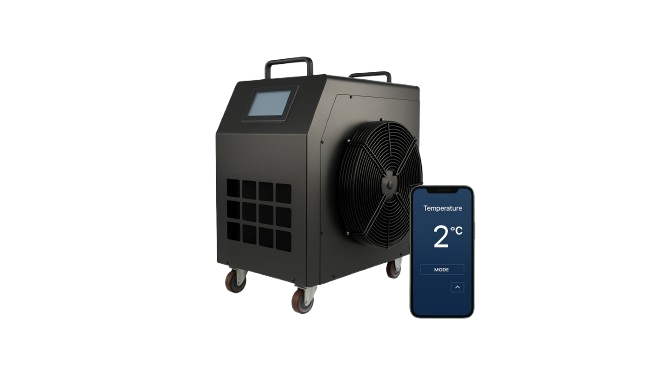
Wi-Fi control makes cold plunging easy. You can use your smartphone app to set and check the ice bath’s temperature from anywhere. You can make sure the water is ready for you after a workout or as soon as you wake up. It makes cold therapy a smooth part of your daily routine instead of something that feels like hard work.
The advanced features always give you a steady and simple way to enjoy your ice bath. The electric chiller runs quietly, so you can relax and work on your wellness in peace, without loud noise from machines.
Easy Maintenance and Water Purity
Eco Hearth made its ice bath easy for you to take care of. You spend more time using it, not cleaning it. The important part is the advanced filter. It keeps the water moving to take out dirt and keep it very clear.
There is also a UV unit in the system. This stops bacteria, viruses, and other tiny things from growing in the water. It shines ultraviolet light to do this. There is a level of clean that basic filters just do not have. You can know your water is safe for a long time.
Conclusion
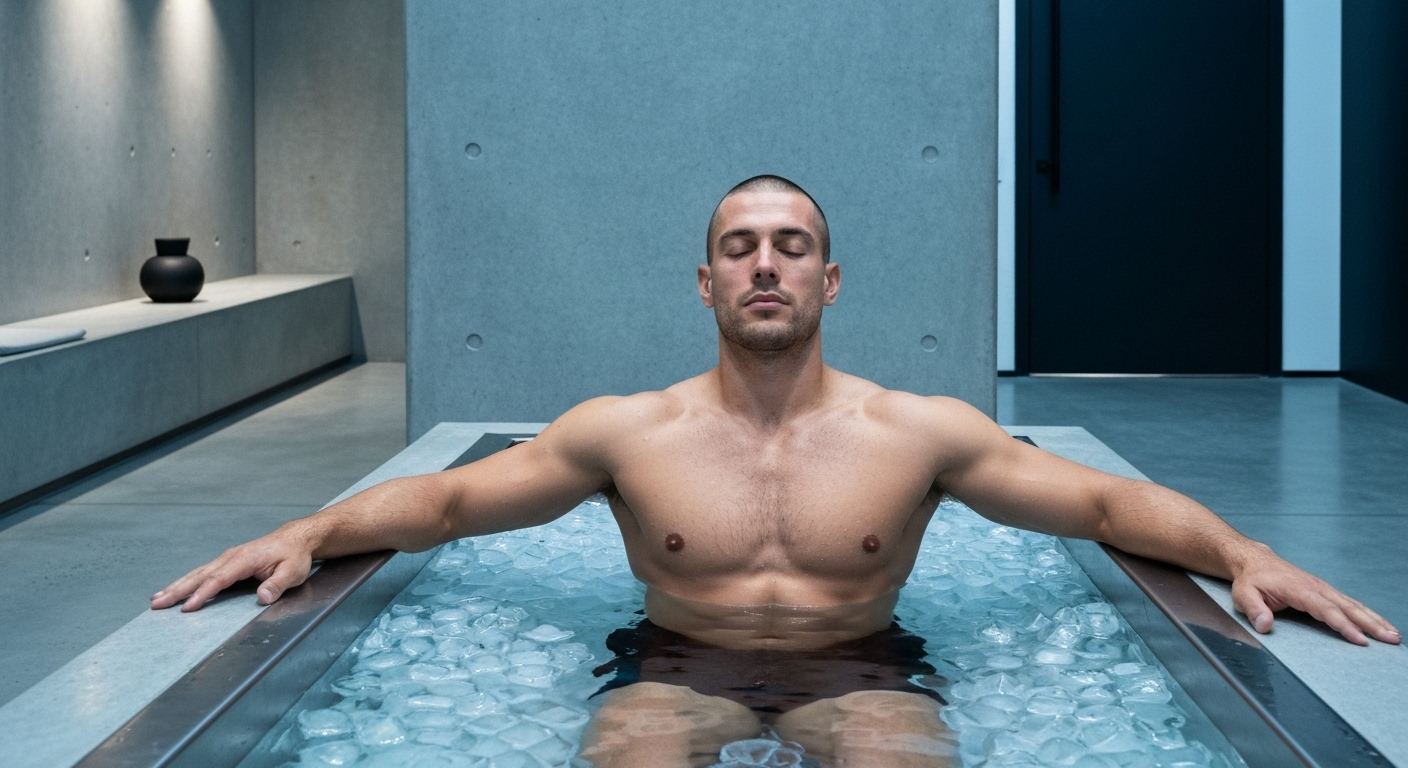
Ice baths give you many health benefits like better muscle recovery, mental clarity, and less stress. It is good to follow safety tips and listen to your body when you start with cold water immersion. If you are an athlete who needs to get better quickly, or if you want to improve your health, adding cold water to your routine could help a lot. You can try Eco Hearth Ice Baths for this, as they use top-quality materials and strong technology. This makes the experience simple and enjoyable. If you want to know more, get in touch with us. We are here to help with your wellness journey!
Frequently Asked Questions
How Often Should I Take an Ice Bath?
How often you should do cold ice baths depends on your goals. If you want to help your body recover, try it about one to three times every week. Athletes can benefit from doing ice baths more often, maybe even every day. You need to listen to what your body tells you and change how often you do ice baths to get the best results.
What Temperature Is Best for Cold Ice Baths?
The best temperature for a cold ice bath is between 50°F and 59°F (10°C to 15°C). This range helps the body get good results like less muscle soreness and faster recovery. It does this without making you too uncomfortable or putting you at risk for being too cold. Always talk with a healthcare professional before you begin.
Can Anyone Try Ice Bathing?
Most people can try cold ice bathing. However, it’s very important to talk with a doctor first. This is needed especially if you have health problems. You should start slow and use the right way to do it. This helps keep you safe and makes the ice bathing work better.
Where Can I Buy a High-Quality Ice Bath Tub?
When you want to buy a good ice bath tub, start by looking at trusted online places, special wellness stores, or the site of the brand that makes it. It is smart to read what other people say in reviews. Look at product details, too. This will help you know if the ice bath tub is strong and does what it should before you spend money on it.
Can a cold ice bath help with muscle recovery after workouts?
Cold ice baths can help with muscle recovery after a workout. They lower swelling, lessen pain, and improve blood flow. This way, they move waste out of muscles and bring good stuff in faster. Many athletes like using ice baths because they want to get back to their best sooner.

